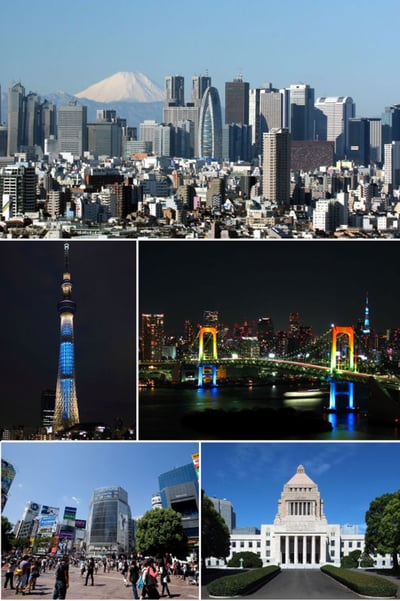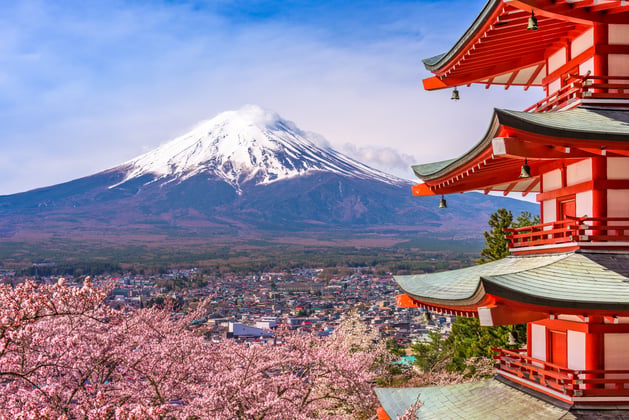 Japan has one of the highest life expectancy rates, an average of 84 years (compared to 78.5 years in the USA, according to numerous statistics), so it is no surprise the Asian country also has an impressive health-care system. Ranked third globally by a Bloomberg report, Japan’s health care system covers medical, dental and prescription drug needs.
Japan has one of the highest life expectancy rates, an average of 84 years (compared to 78.5 years in the USA, according to numerous statistics), so it is no surprise the Asian country also has an impressive health-care system. Ranked third globally by a Bloomberg report, Japan’s health care system covers medical, dental and prescription drug needs.
(Photo, inset right) JAPAN HAS ONE OF WORLD’S HIGHEST LIFE EXPECTANCY RATES: 84 years, compared to 78.5 years in the USA. Pictured: Montage of Tokyo. Photo: Hogweard/Wikimedia Commons
In the latest installment of our Health Care Around the World series, the UMHS Endeavour looks at Japan’s health system and what the public and students at American and Caribbean medical schools can learn from it. We will examine the basics of Japan’s system, its similarities to the Affordable Care Act/Obamacare, and more.
Universal Health Care in Japan
A 2012 article in The Diplomat.com explained the similarities and differences between Japan’s health care and Obamacare.
“The Japanese use a universal healthcare insurance scheme that requires participation (like the Obama program) and has several different methods by which insurance is delivered depending upon whether one is self-employed or employed by a company or government entity,” Dr. John W. Traphagan wrote in the Diplomat. “For those who are employed by corporations, payroll taxes paid by both employees and employers support the program, while the self-employed pay premiums adjusted to income levels.”
In 2000, Dr. Traphagan noted, the Japanese system expanded to include long-term care insurance, mandatory for people age 40 and up. People 40 and older simply pay an additional premium on top of the national health insurance plan. The long-term insurance covers everything from nursing homes to home health worker services and more.
Discover if a Caribbean Medical School is right for you.
Learn about the most popular alternative path to becoming a doctor.
Costs for Japanese Health Care Half of What U.S. Pays
Japan’s health care costs half of what America pays, a 2009 Washington Post article said.
How is this possible? Japan “does so by banning insurance company profits, limiting doctor fees and accepting shortcomings in care that many well-insured Americans would find intolerable,” the Washington Post said.
According to the article, the Japanese can use any doctor they choose, from primary care physicians to specialists. The Japanese visit the doctor an average of 14 times per year, and the country also has one of the world’s lowest infant mortality rates.
There are no denials of coverage due to preexisting conditions. Costs for treatment and medication are set by the Japanese government.
Of course, Japanese doctors don’t make the salaries that those in the U.S. do, but administrative costs for medicine are “four times lower than they are in the United States, in part because insurance companies do not set rates for treatment or deny claims,” the Washington Post said. “By law, they cannot make profits or advertise to attract low-risk, high-profit clients.”

ONE OF WORLD'S HEALTHIEST PLACES: Okinawa, Japan, home to many people ages 90 to 100. Photo: Fg2/Wikimedia Commons
Disadvantages of Japanese System
Japan’s health care system is not perfect. The Washington Post said. In the past, Japan has had trouble shortening the length of patient hospital stays. Because access to health care is so widely available, the government has had trouble being a “gatekeeper” for people who either overuse or abuse the system.
"The government has been trying for more than 20 years to put up gates," Naoki Ikegami, professor of health policy and management at the Keio University School of Medicine in Tokyo, told the Washington Post in 2009. "But we don't train general practitioners to be gatekeepers."
The nation has also faced shortages of obstetricians, anesthesiologists and emergency room specialists “because of relatively low pay, long hours and high stress at many hospitals,” the article said.
Many Japanese doctors get fed up with the long hours and low pay in public hospitals and move to more lucrative jobs in private clinics.
A Quick Look at Japan’s Health Care
Below are facts about Japan’s health-care system from the Commonwealth Fund.
- Statutory health insurance system, with approximately 3,500 noncompeting public, quasi-public, and employer-based insurers.
- General tax revenue; insurance contributions
- Majority buy coverage for cash benefits/cost-sharing
- Coinsurance reduced to 1% after $999 (U.S.) monthly cap.
- Low-income monthly out-of-pocket ceiling: $441 U.S.; reduced cost-sharing for young children and older people
(Top photo): Mt. Fuji in Japan. Photo: Deposit Photos
About UMHS:
Built in the tradition of the best US universities, the University of Medicine and Health Sciencesfocuses on individual student attention, maintaining small class sizes and recruiting high-quality faculty. We call this unique approach, “personalized medical education,” and it’s what has led to our unprecedented 96% student retention rate, and outstanding residency placements across the US and Canada. UMHS is challenging everything you thought you knew about Caribbean medical schools.

Scott is Director of Digital Content & Alumni Communications Liaison at UMHS and editor of the UMHS Endeavour blog. When he's not writing about UMHS students, faculty, events, public health, alumni and UMHS research, he writes and edits Broadway theater reviews for a website he publishes in New York City, StageZine.com.

















